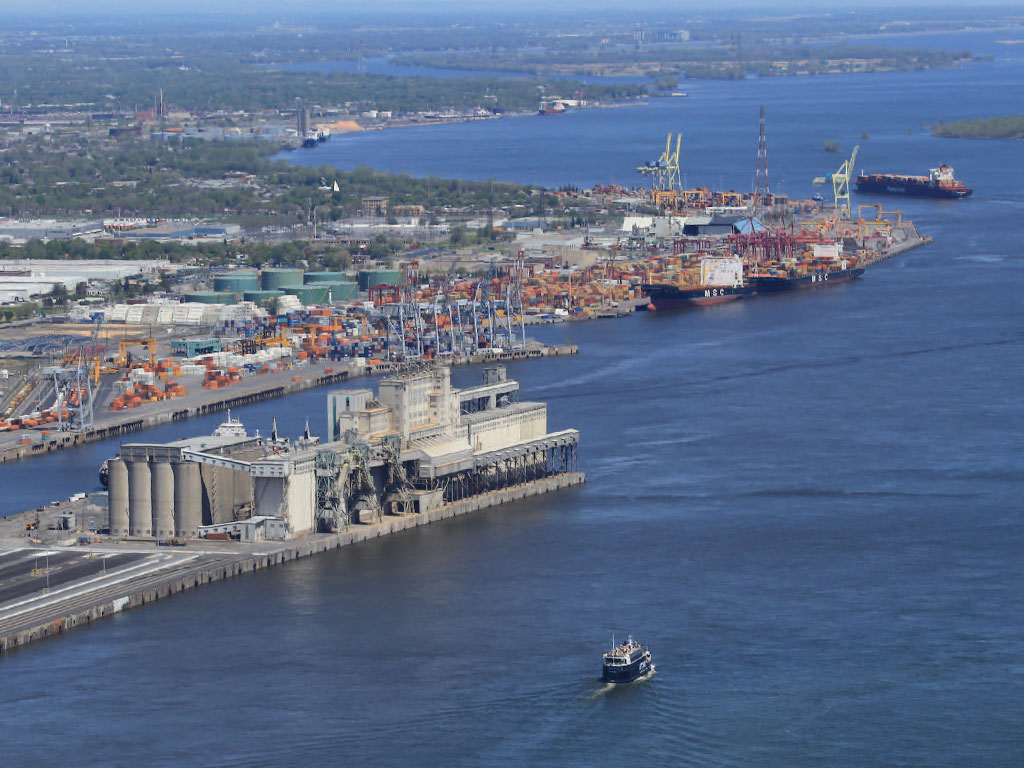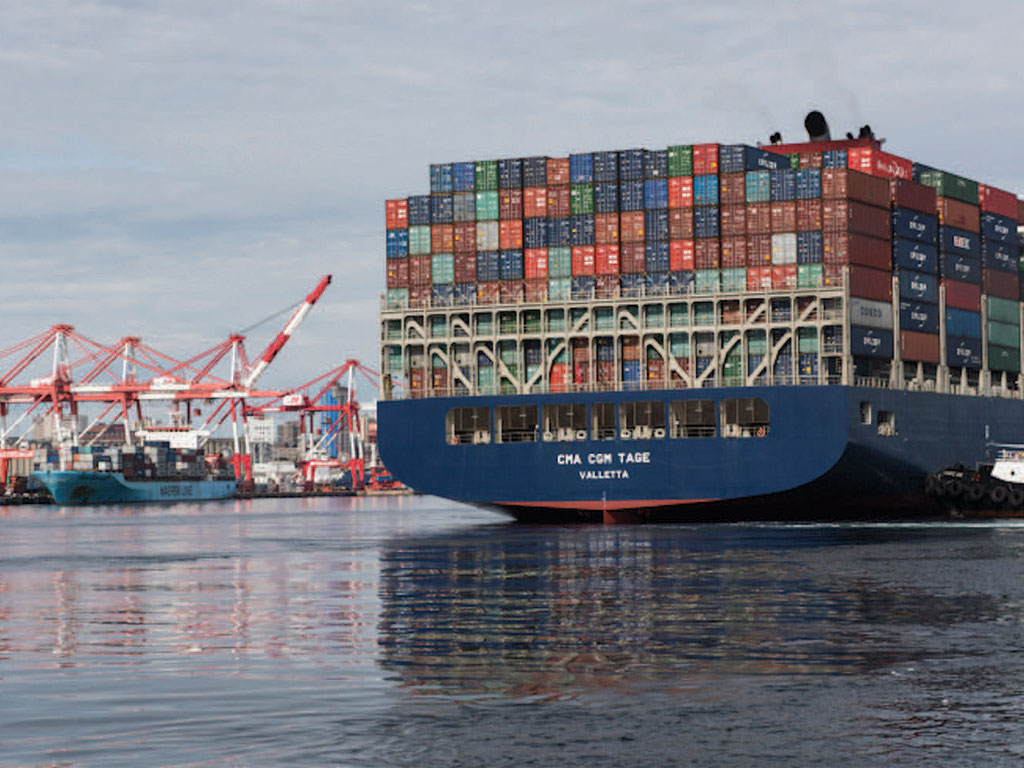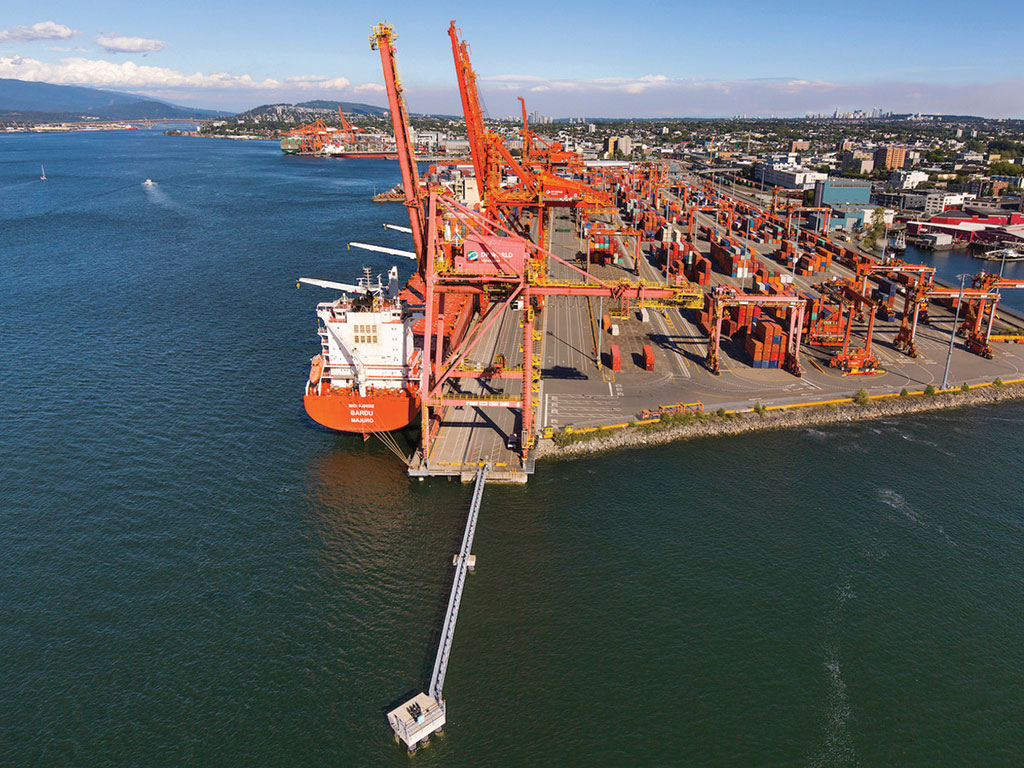A year ago at this time, the great majority of Canadian ports were suffering cargo declines as the devastating COVID-19 was in full flight and the global economy was being hammered by the worst downturn in decades. Traffic levels were plunging at levels ranging from the low single digits to high double digits. Pretty exceptional was the performance of the Port of Sept-Iles, whose iron ore-dominated traffic growth of nearly 13% was sparked by a significant rise in commodity prices (see separate report North America’s leading iron ore export hub surging towards new peaks). Fortunately, the outlook has improved substantially as vaccination roll-outs accelerate rapidly and caseloads diminish in the advanced economies.
Thus, following a pandemic-ravaged 2020, Canada’s economy picked up steam in the first six months of 2021. After a decline of 5.4% in 2020, Canada’s GDP is forecast to grow by 6.1% this year by the Organization for Economic Co-operation and Development (OECD). U.S. economic growth could attain 6.4% while global output could progress 5.8%, according to the OECD’s latest revised assessment. So Canadian ports are able to give priority once again to enhancing their competitiveness by expanding capacity.
Canadian East Coast Ports
At Montreal, Canada’s second largest port after Vancouver, various positive factors are fuelling optimism. After seeing its volume drop in 2020 by about 14% to 35 million metric tons and container cargo decrease by 6% to 1.6 million TEUs, the first half of 2021 was showing recovery momentum.
“The return of fluidity, with a dwell time of less than two days in June, demonstrates the robustness of our Port of Montreal model,” noted, first of all, Rosetta Iacono, Director Growth and Development. “Container volumes are coming back to Montreal, despite the past year challenges, with a strong forecasted month of June.
“Another factor in favor of our recovery,” Iacono said, “is the absence of vessel congestion. Unlike the West Coast ports with weeks of vessel congestion and East Coast ports struggling to manage the container bottle necks, the absence of vessel congestion in Montreal can be explained by the optimal use of our 11 container berths, providing plenty of capacity to handle multiple vessel calls. Specifically: we handle 10 to 12 container ships per week, there is no waiting time at anchorage.”

While Europe remains Montreal’s largest market, maritime trade with Asia now represents nearly 28% of the port’s container business.
“We see this rising trend from Asia continue in 2021,” Iacono indicated. “Our carriers continue to increase the Asia offering via connections through Mediterranean ports (transshipment) which opened Asia to Ontario and Quebec’s shippers. As two-thirds of Canada’s population lives in Quebec and Ontario, many importers have quickly realized that it is a viable option to ship from Asia via Montreal because we are closer to the market and closer to their customers and distribution centers.
“The Midwest remains a significant market for the Port of Montreal. Our fluid and reliable operations and rail connections with two class one rail carriers CN & CP explain why the Port of Montreal continues to be the port of choice for our customers the Midwest markets.”
On the infrastructure front, a rail optimization project recently began. The port also launched the construction of a road link in the Viau sector. The objective of the overpass project is to improve road accessibility to the port and alleviate trucking.
Meanwhile, the Montreal Port Authority (MPA) is moving forward in the development of its $750-million Contrecoeur container terminal project. The facility will have a maximum annual capacity of 1.15 million 20-foot equivalent units (TEUs) upon planned completion in 2025.
“The expansion of the Port of Montreal at Contrecoeur reached a very important milestone in the past several months with the favourable ministerial decision for the project to be carried out,” said Paul Bird, the MPA’s Vice-President, Contrecoeur.
And this past July marked another key new phase when the MPA announced the launching of a national and international procurement process. Industry players in Canada and abroad have been invited to submit a proposal to enter into a long-term design-build-finance-operate-maintain agreement. This includes local operators, Termont and Montreal Gateway Terminals (MGT) who took part in the preliminary discussions.
After posting a tonnage increase for the fourth consecutive year in 2019, the Port of Quebec saw its overall volume drop by about 8% in 2020 to 27 million tons. On the other hand, while liquid bulk declined, solid bulk performed strongly (up 35%) thanks to a marked increase in the agro-food sector. The trendline in 2021 points to a return of growth figures.
However, the port’s ambition to enter the St. Lawrence container trades recently received a major setback. The federal government rejected the Quebec Port Authority’s (QPA) proposed Laurentia container terminal project, bluntly opining that it does not meet the standards of economic development that fully respect the environment. This means the port must re-focus on other infrastructure growth to expand its vital role as a deepwater transloading hub for bulk trades with the Great Lakes region.
Overall cargo tonnage at oil-dominant Port Saint John for the year 2020 was 25.9 million tons, a 2% increase over 2019. In the container sector, units handled increased by 15% to 79,179 TEUs.
Further bolstering container activity has been the recent start-up of a regular weekly container service from the Mediterranean to Saint John, following an agreement announced by Hapag-Lloyd and Canadian Pacific, which has introduced an intermodal service with North America’s hinterland.

For its part, the Port of Halifax saw its total and container cargo decline in 2020, but not to the extent that was initially anticipated. Container volume added up to 507,185 TEUs versus 547,000 TEUs in 2019. First half 2021 statistics pointed to a rebound in container traffic thanks to the continued strength which started late last year in inbound cargo from Asia.
Positive factors for the Port of Halifax include the continuation of ultra-class vessel calls at PSA Halifax including the largest container ships ever to call a Canadian port (the 16,022 TEU containerships CMA CGM Marco Polo and Jules Verne), the new MSC service at PSA Halifax, big ships over 8600 TEU calling at Ceres-Halifax, and the continued support of Zim, Tropical, Oceanex, ACL, Eimskip, Ocean Alliance, and THE Alliance. The calls by the Marco Polo and Jules Verne are a visible confirmation the port’s Big Ship status and bodes well for attracting future ultra-large containership calls.
And the S&P agrees with the positive assessment. In August, the rating agency revised HPA’s outlook to positive from stable and affirmed HPA’s investment-grade credit rating of A+. The report states, “We view HPA’s management and governance assessment as very strong. We consider management to be experienced and knowledgeable regarding markets and the industry. Its policies and governance have consistently allowed it to meet its financial and operational goals.”
Meanwhile, the Port of Halifax is pleased with the progress of a new project to establish what could be termed “a living lab” to focus on transportation and logistics issues in the marine cargo sector. Called PIER for Port Innovation, Engagement and Research, it will provide opportunities to interact directly with end users, receive actionable insights and allow solutions to be visible to industry specific investors. Andrew Black, the port’s director of strategic technology, reports the project has attracted both international and national interest. PIER participants will interact through a physical space that was formerly the Seaport Market where renovation is expected to be completed this fall.
By far the leading entity amongst Canadian ports on the Great Lakes, the Hamilton-Oshawa Port Authority (HOPA) benefited from a big surge in bulk and project cargoes in the early months of 2021 feeding residential construction and urban development projects in the Greater Toronto Hamilton Area. The merged ports of Hamilton and Oshawa handled 10.6 million tonnes in 2020 and are on track to exceed that volume this year.
A highlight for this year has certainly been the launching on June 10 of a container feeder service between Hamilton and Montreal. It was developed by Hamilton Container Terminal (HCT) in close partnership with HOPA, Groupe Desgagnés, Federal Marine Terminals, MSC and the Port of Montreal. Some 300 containers were loaded onto the MV Sedna Desgagnés as part of the shortsea shipping venture that will be followed by other voyages on inducement later this year, with the objective of expanding to 20+ sailings in 2022.
Canadian West Coast Ports
Total cargo volume through the Port of Vancouver in 2020 increased by 1% from 144.2 million tons to 145.5 million tons over the same period in 2019, with new annual records set for grain, potash, and containers. China continues to be the port’s largest trading partner, with two-way trade climbing 18% in 2020. China alone accounted for 34.9 million tons of exported and imported cargo.

For the fifth year in a row, global demand for Canadian grain resulted in a new annual record of 35.1 million tons of grain shipped both in bulk ships and containers, an increase of fully 24% compared to the previous year.
Container traffic in 2020 attained a record 3.5 million TEUs, an increase of 2% compared to the previous year. The port authority recently upgraded its container forecasts, and indeed the year-to-date figures (a double digit spike) to end-May appeared to justify the optimism. The five-month tally amounted to 1.7 million TEUs compared to the year-earlier 932,000 TEUs.
In northern British Columbia, the Prince Rupert Port Authority (PRPA) set another record for annual throughput in 2020, with 32.4 million tonnes of cargo handled – 9% more than in 2019.
Factory shutdowns in Asia and locked down economies in North America caused a 19% drop in container traffic in Q2 2020. However, volumes are now rebounding strongly with cumulative box traffic in the first five months of 2021 at 4.4 million tons versus 4 million tons a year earlier.




